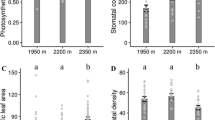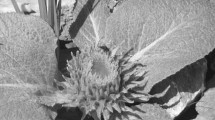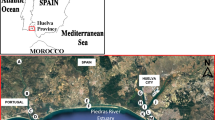Abstract
The global picture of plant reproduction at high altitudes is still diffuse due to conflicting reports (e.g., about which are the prevalent breeding systems) and incomplete geographical and taxonomic coverage of high-altitude ecosystems. This paper reports on the reproductive biology of Kentrothamnus wedellianus, a shrub inhabiting the Puna semidesert in Argentina and Bolivia at ca. 3,600 m a.s.l. A set of four traits, including a high pollen/low nectar floral reward strategy, homogamy, a dry stigma, and partial self-compatibility, appear to be central for K. weddellianus to accomplish sexual reproduction in the high-altitude Puna. The existence of an entirely different set of characteristics in the related species Ochetophila nana suggests that adaptation to reproduction at high altitudes can be achieved through different pathways. Hence, the final results may strongly diverge from the patterns found in lowland species of each lineage, or not. More case studies still seem to be necessary before specific patterns can be discerned within the panorama of high-altitude plant reproduction.


Similar content being viewed by others
References
Aagesen L, Medan D, Kellermann J, Hilger HH (2005) Phylogeny of the tribe Colletieae (Rhamnaceae)—a sensitivity analysis of the plastid region trnL–trnF combined with morphology. Pl Syst Evol 250:197–214
Anderson GJ, Bernardello G, Lopez P, Stuessy TF, Crawford DJ (2000) Dioecy and wind pollination in Pernettya rigida (Ericaceae) of the Juan Fernandez Islands. Bot J Linn Soc 132:121–141
Arroyo MTK, Squeo FA (1987) Experimental detection of anemophily in Pernettya mucronata (Ericaceae) in western Patagonia, Chile. Bot Jahrb Syst 108:537–546
Arroyo MTK, Primack RB, Armesto JJ (1982) Community studies in pollination ecology in the high temperate Andes of central Chile. I. Pollination mechanisms and altitudinal variation. Amer J Bot 69:82–97
Basilio AM, Medan D (2001) Pollinator assemblages of Colletia spinosissima (Rhamnaceae): composition, behavior, and specificity. Phyton (Buenos Aires) 2001:129–139
Bertin IR, Newman CM (1993) Dichogamy in angiosperms. Bot Rev 59:112–152
Cabrera AL, Willink A (1973) Biogeografía de América Latina. Organización de los Estados Americanos, Washington DC
Corbet SA (1990) Pollination and the weather. Israel J Bot 39:13–30
Dafni A, Motte Maués M (1998) A rapid and simple procedure to determine stigma receptivity. Sex Plant Reprod 11:177–180
D’Ambrogio A, Medan D (1993) Comportamiento reproductivo de Colletia paradoxa (Rhamnaceae). Darwiniana 32:1–14
Duan YW, Zhang TF, Liu JQ (2007) Interannual fluctuations in floral longevity, pollinator visitation and pollination limitation of an alpine plant (Gentiana straminea Maxim., Gentianaceae) at two altitudes in the Qinghai-Tibetan Plateau. Pl Syst Evol 267:255–265
Fabbro T, Körner C (2004) Altitudinal differences in flower traits and reproductive allocation. Flora 199:70–81
Fagua JC, Gonzalez VH (2007) Growth rates, reproductive phenology, and pollination ecology of Espeletia grandiflora (Asteraceae), a giant Andean caulescent rosette. Plant Biol 9:127–135
García-Camacho R, Totland Ø (2009) Pollen limitation in the alpine: a meta-analysis. Arctic Antarctic Alpine Res 41:103–111
Heslop-Harrison Y, Shivanna KR (1977) The receptive surface of the angiosperm stigma. Ann Bot 41:1233–1258
Johnston MC (1973) Revision of Kentrothamnus (Rhamnaceae). J Arnold Arboretum 54:471–473
Kellermann J, Medan D, Aagesen L, Hilger HH (2005) Rehabilitation of the South American genus Ochetophila Poepp. ex Endl. (Rhamnaceae: Colletieae). N Z J Bot 43:865–869
Körner C (1999) Alpine plant life. Springer, Berlin
Kühn I, Bierman SM, Durka W, Klotz S (2006) Relating geographical variation in pollination types to environmental and spatial factors using novel statistical methods. New Phytol 172:127–139
Ladd PG, Arroyo MTK (2009) Comparisons of breeding systems between two sympatric species, Nastanthus spathulatus (Calyceraceae) and Rhodophiala rhodolirion (Amaryllidaceae), in the high Andes of central Chile. Pl Species Biol 24:2–10
Lande R, Shannon S (1996) The role of genetic variation in adaptation and population persistence in a changing environment. Evolution 50:434–437
Larson BMH, Barrett SCH (2000) A comparative analysis of pollen limitation in flowering plants. Biol J Linn Soc 69:503–520
Linder HP (1998) Morphology and evolution of wind pollination. In: Owens SJ, Rudall PJ (eds) Reproductive biology. Royal Botanic Gardens, Kew, pp 123–135
Lloyd DG, Webb CJ (1986) The avoidance of interference between the presentation of pollen and stigmas in angiosperms. I. Dichogamy. N Z J Bot 24:135–162
Martínez Carretero E (1995) La Puna argentina: delimitación general y división en distritos florísticos. Bol Soc Argent Bot 31:27–40
Medan D (1991) Reproductive phenology, pollination biology, and gynoecium development in Discaria americana (Rhamnaceae). N Z J Bot 29:31–42
Medan D (1993) Breeding system and maternal success of a perennial hermaphrodite, Discaria americana (Rhamnaceae). N Z J Bot 31:175–184
Medan D (2003) Reproductive biology of of the Andean shrub Discaria nana (Rhamnaceae). Plant Biol 5:94–102
Medan D, Aagesen L (1995) Comparative flower and fruit structure in the Colletieae (Rhamnaceae). Bot Jahrb Syst 117:531–564
Medan D, Arce ME (1999) Reproductive biology of the Andean-disjunct genus Retanilla (Rhamnaceae). Plant Syst Evol 218:281–298
Medan D, Basilio AM (2001) Reproductive biology of Colletia spinosissima (Rhamnaceae) in Argentina. Plant Syst Evol 229:79–89
Medan D, D’Ambrogio AC (1998) Reproductive biology of the andromonoecious shrub Trevoa quinquenervia (Rhamnaceae). Bot J Linn Soc 126:191–206
Medan D, Devoto M (2005) Reproductive ecology of a perennial outcrosser with a naturally dissected distribution. Plant Syst Evol 254:173–184
Medan D, Montaldo NH (2005) Ornithophily in the Rhamnaceae: the pollination of the Chilean endemic Colletia ulicina. Flora 200:339–344
Medan D, Torretta JP (2006) Evolución de rasgos reproductivos en Colletia (Rhamnaceae: Colletieae). Resúmenes, 22 Reunión Argentina de Ecología, Córdoba
Medan D, Tortosa RD (1981) Nódulos actinomicorrícicos en especies argentinas de los géneros Kentrothamnus, Trevoa (Rhamnaceae) y Coriaria Coriariaceae). Bol Soc Argent Bot 20:71–81
Medan D, Vasellati MV (1996) Nonrandom mating in Discaria americana (Rhamnaceae). Plant Syst Evol 201:233–241 [corrigenda: Plant Syst Evol 203:1−2, 1997]
Medan D, Basilio AM, Devoto M (1999) Biología reproductiva de Discaria chacaye (Rhamnaceae: Colletieae) en el Parque Nacional Lanín, Neuquén. Resúmenes, 19 Reunión Argentina de Ecología, Tucumán
Medan D, Montaldo NH, Devoto M, Mantese A, Vasellati V, Roitman GG, Bartoloni NH (2002) Plant-pollinator relationships at two altitudes in the Andes of Mendoza, Argentina. Arctic Antarctic Alpine Res 34:233–241
Medan D, Arbetman M, Chaia EE, Premoli AC (2012) Interspecific and intergeneric hybridization in South-American Discaria and Ochetophila (Rhamnaceae-Colletieae). Plant Syst Evol. doi:10.1007/s00606-012-0646-0
Muñoz AA, Arroyo MTK (2006) Pollen limitation and spatial variation of reproductive success in the insect pollinated shrub Chuquiraga oppositifolia (Asteraceae) in the Chilean Andes. Arctic Antarctic Alpine Res 38:608–613
Plowright RC (1985) Corolla depth and nectar concentration: and experimental study. Can J Bot 65:1011–1013
Primack RB (1979) Reproductive biology of Discaria toumatou (Rhamnaceae). N Z J Bot 17:9–13
Ramos-Jiliberto R, Domínguez D, Espinoza C, López G, Valdovinos FS, Bustamante RO, Medel R (2010) Topological change of Andean plant–pollinator networks along an altitudinal gradient. Ecol Complexity 7:86–90
Rathcke BJ (2003) Floral longevity and reproductive assurance: seasonal patterns and an experimental test with Kalmia latifolia (Ericaceae). Amer J Bot 90:1328–1332
Ruthsatz B (1977) Pflanzengesellschaften und ihre Lebensbedingungen in den Andinen Halbwüsten Nordwest-Argentiniens. Dissertationes Botanicae 39:1–168
Steinacher G, Wagner J (2010) Flower longevity and duration of pistil receptivity in high mountain plants. Flora 205:376–387
Thiel-Egenter C, Gugerli F, Alvarez N, Brodbeck S et al (2009) Effects of species traits on the genetic diversity of high-mountain plants: a multi-species study across the Alps and the Carpathians. Global Ecol Biogeography 18:78–87
Torres-Díaz C, Gómez-González S, Stotz GC, Torres-Morales P, Paredes B, Pérez-Millaqueo M, Gianoli E (2011) Extremely long-lived stigmas allow extended cross-pollination opportunities in a high Andean plant. PLoS ONE 6:e19497
Tortosa RD (1989) El género Colletia (Rhamnaceae). Parodiana 5:279–332
Tortosa RD, Aagesen L, Tourn GM (1996) Morphological studies in the tribe Colletieae (Rhamnaceae): analysis of architecture and inflorescences. Bot J Linn Soc 122:353–367
Totland Ø, Sottocornola M (2001) Pollen limitation of reproductive success in two sympatric alpine willows (Salicaceae) with contrasting pollination strategies. Amer J Bot 88:1011–1015
Webb CJ (1985) Protandry, pollination, and self-incompatibility in Discaria toumatou. N Z J Bot 23:331–335
Yeo PF (1993) Secondary pollen presentation. Springer, Wien
Acknowledgments
L. Compagnucci, J.C. Mariluis, P. Mulieri, L. Patitucci, S. Olea, A. Roig-Alsina, F.C. Thompson and J.P. Torretta helped with insect identification. In the field, G.G. Roitman helped with insect collection and M.C. Alvarez with experimental work. Comments by Lone Aagesen, Mariano Devoto, Norberto Montaldo and a anonymous reviewer helped to improve a previous draft. Financial support was granted by Consejo Nacional de Investigaciones Científicas y Técnicas (Argentina) to D. Medan [PIP 5704].
Author information
Authors and Affiliations
Corresponding author
Rights and permissions
About this article
Cite this article
Medan, D., Zarlavsky, G. & Bartoloni, N.J. Plant reproduction in the high-Andean Puna: Kentrothamnus weddellianus (Rhamnaceae: Colletieae). Plant Syst Evol 299, 841–851 (2013). https://doi.org/10.1007/s00606-013-0766-1
Received:
Accepted:
Published:
Issue Date:
DOI: https://doi.org/10.1007/s00606-013-0766-1




